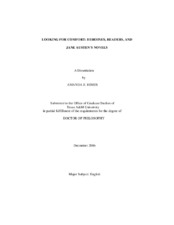| dc.description.abstract | Comfort—with its various connotations of physical ease, wealth, independence,
and service—is an important concept to Jane Austen, who uses comfort in her novels to
both affirm and challenge accepted women’s roles and status in her culture. In the late
eighteenth century, new ideas of physical comfort emerged out of luxury along with a
growing middle class, to become something both English people and foreigners
identified with English culture. The perceived ability of the English to comfort well gave
them a reason for national pride during a time of great anxieties about France’s cultural
and military might, and Austen participates in her culture’s struggle to define itself
against France. Austen’s “comfort†is the term she frequently associates with women,
home, and Englishness in her works.
Austen’s depiction of female protagonists engaged in the work of comforting
solaces modern readers, who often long for the comfort, good manners, and leisure
presented in the novels. Surveys of two sample groups, 139 members of the Jane Austen
Society of North America and 40 members of the online Republic of Pemberley, elicit
data confirming how current readers of Austen turn to her works for comfort during
times of stress or depression. Although some readers describe using Austen’s novels as a form of escapism, others view their reading as instructive for dealing with human
failings, for gaining perspective on personal difficulties, and for stimulating their
intellects. Austen’s fiction grapples with disturbing possibilities, such as the liminal
position of powerless single women at the mercy of the marriage market and fickle
family wishes, as much as it provides comforting answers. Comforts (decent housing,
love in marriage, social interaction) are such a powerful draw in Austen’s works because
women’s discomfort is so visible, and for many, so likely. Thus, Austen’s comfort
challenges as much as it reassures her audience. | en |


